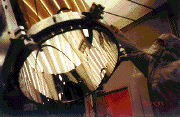Multiwavelength Milky Way: Telescopes
Different telescopes for different wavelengths
![]()
I. Optical telescopes
II. Long-wavelength telescopes - infrared and radio waves
III.Short-wavelength telescopes - ultraviolet, x-rays, and gamma rays
 telescope - an instrument used to gather light radiated from distant objects.
telescope - an instrument used to gather light radiated from distant objects.
I. There are two basic kinds of optical (gathering visible light) telescopes. Refracting telescopes use convex lenses, at the front of a tube, to gather and focus incoming light. The image formed is magnified for the viewer through an eyepeice lens at the back end of the tube. Reflecting telescopes make use of a primary concave mirror to gather light. A secondary mirror (like the eyepiece lens of a refractor) is often used to channel the light rays to a detector. Our eyes are detectors, but in astronomical studies an electronic device is often used instead.
Most optical telescopes are located on the ground (housed in domed observatories), but some are in space. A well known optical telescope in space is the Hubble Space Telescope.

The Hubble Space Telescope
Back to top
II. In the long-wavelength region of the electromagnetic spectrum, radio waves pass easily through the earth's atmosphere. Some infrared wavelengths also get through, but water vapor absorbs much of the infrared radiation as well as microwave radiation coming from astronomical objects. It is better, to observe these phenomena from space.
Infrared telescopes follow the same design as optical reflecting telescopes, but use an infrared light detector at the focus. Infrared telescopes on the ground must be located in dry regions, to avoid the water vapor that absorbs this radiation.

A part of the Very Large Array in New Mexico
Microwave and Radio telescopes have designs much like the reflecting optical telescopes. A large parabolic dish, with an antenna tuned to the desired frequency, is used to focus the incoming radio waves. Because radio waves have a much longer wavelength than optical light, the large dishes do not have to be mirror-smooth. In fact many radio telescope are composed of metal mesh. The largest radio telescope dish, the Arecibo Observatory, is 305 meters (1,000 ft) across, and is located in Puerto Rico. Even though the Arecibo telescope is large, it cannot see an object with the detail (resolving power) that a large optical telescope can. To increase resolving power, two or more radio telescopes, separated by large distances, can be used together to function as one huge radio telescope. This is called interferometry, and is the basis for the Very Large Array radio observatory in New Mexico.
Back to top
III. In much of the short-wavelength region of the electromagnetic spectrum, telescopes must be located in space, because the high-energy photons cannot penetrate the earth's atmosphere.
Ultraviolet telescopes have primary mirrors which are coated with special materials that make it possible to reflect ultraviolet light.
X-ray telescopes must use a different design than optical telescopes. The high-energy photons like to penetrate mirrors instead of reflecting of of them. The mirrors that focus x-rays are made to be almost parallel to the incoming rays. The x-rays will then glance off of the coated (usually with gold or nickle) mirrors. The mirrors used on the Chandra X-ray Observatory are coated with iridium.
Gamma rays have such high energies, that mirrors cannot be used to focus the radiation. Instead, gamma-ray detectors are used to record photons and reconstruct an image.

Mirrors that were placed on the Chandra X-ray Observatory.
Credit:NASA/CXC/SAO
Back to top
Related Online Resources:
IMAGERS - an introduction to remote sensing and satellite imagery for children in grades K-8

